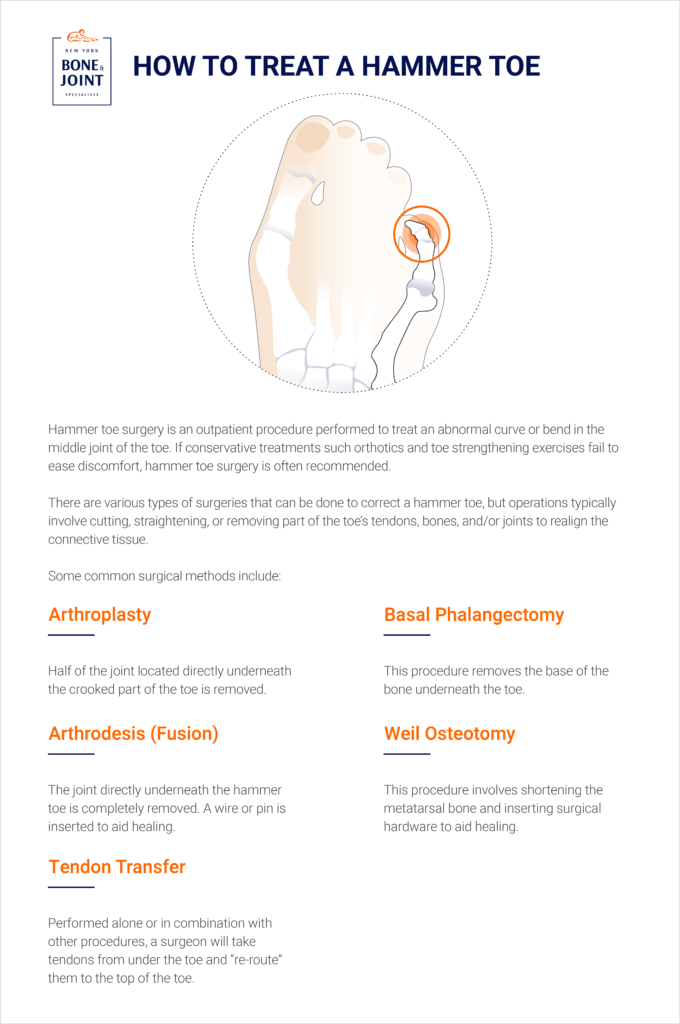Hammer toes are among the most common foot conditions we treat at New York Bone & Joint Specialists, often causing significant foot and ankle pain.
Fortunately, most hammer toes can be corrected quickly and comfortably with conservative therapy. Surgery is usually only needed in severe or long-standing cases.
A hammer toe is an unnatural bend in the middle joint of one of your smaller toes, which can make every step painful. Left untreated, the joint becomes stiffer and more painful over time. Early treatment offers the best chance to restore mobility and avoid surgery.
If surgery is necessary, our hammer toe specialists in New York City use advanced, minimally invasive techniques to ensure excellent outcomes and faster recovery.
Don’t let hammer toe pain slow you down—schedule your consultation with New York Bone & Joint Specialists today.
Understanding Hammer Toes: Definition and Symptoms
A hammer toe is a deformity where the middle joint of a smaller toe bends upward, while the tip points downward—creating a “hammer-like” shape. This abnormal bend often leads to pain, stiffness, and irritation as the toe rubs against shoes.
Three types of hammer toe:
- Flexible: The toe has begun to curl, but can still be straightened.
- Semi-rigid: The toe is partially stiff and difficult to move.
- Rigid: The toe is stuck in a bent position and cannot be straightened without surgery.
Common hammer toe symptoms include:
- Pain on top of the affected toe or in the ball of the foot
- Pain that worsens when wearing narrow shoes
- Stiffness or difficulty moving the toe
- Corns or calluses caused by rubbing against shoes
- Swelling, redness, or skin discoloration
- Difficulty walking in severe cases
What Causes Hammer Toes? Diagnosis and Risk Factors
Hammer toes develop when muscles and tendons in the toe become imbalanced, often from being forced into an unnatural position for too long—such as wearing tight or narrow shoes.
Common causes include:
- Ill-fitting shoes: High heels or shoes with narrow toe boxes
- Foot shape: Flat feet, high arches, or unusually long toes
- Bunions: Can push neighboring toes out of alignment
- Injury: Stubbed, jammed, or broken toes
- Medical conditions: Diabetes, rheumatoid arthritis, or nerve disorders
- Gender: Women are more likely to develop hammer toes
Because hammer toe is a progressive condition, early diagnosis is key. Our specialists will:
- Examine your toe joints and range of motion
- Check for pain or stiffness by gently moving the toe
- Assess your walking pattern
- Review your footwear habits
- Order X-rays if needed to evaluate bone alignment
Comprehensive Hammer Toe Treatment Options
Hammer toes can be successfully corrected with conservative treatments if you start therapy while the toe is still flexible. Treatments aim to relieve pressure on the joint and keep it aligned so walking is less painful.
Most hammer toes can be corrected without surgery if treatment begins early, while the toe is still flexible. Our goal is to relieve pressure, restore alignment, and make walking comfortable again.
Common conservative treatments include:
- Pads & splints: Cushion corns and keep the toe straight
NSAIDs: Over-the-counter or prescription anti-inflammatory medication to reduce pain and swelling - Orthotics: Custom or store-bought inserts to improve foot alignment
Hammer Toe Surgery: When It’s Needed
If your hammer toe is rigid or conservative care hasn’t worked, surgery may be the best solution. Our minimally invasive techniques are designed for quick healing, smaller incisions, and less downtime.
Common surgical procedures include:
- Arthroplasty: Removes a small piece of bone to straighten the toe
- Tendon release: Lengthens tight tendons or ligaments, causing the bend
- Arthrodesis: Fuses the joint in a straight position (used in severe cases)
- Tendon transfer: Moves a tendon to the top of the toe for better alignment
- Weil osteotomy: Shortens the metatarsal bone to relieve pressure in the ball of the foot
After surgery, most patients wear a surgical shoe or use crutches for about four weeks. Stitches or pins are typically removed within two to four weeks, and elevation is recommended during the first week to reduce swelling.
Why Choose New York Bone & Joint Specialists for Hammer Toe Treatment
- Expert hammer toe specialists: Advanced training in orthopedic foot conditions and surgery
- Patient-first approach: We prioritize conservative treatments before recommending surgery
- State-of-the-art diagnostics: Precision imaging and gait analysis for accurate diagnoses
- Minimally invasive techniques: Faster recovery, less discomfort, and minimal scarring
- Proven success: 90% of our patients recover fully without surgery
Our commitment to preserving your natural joint structure and restoring your mobility means you can get back to walking comfortably—and living fully—sooner.
Make an appointment today
Ready to take the first step toward relief? Schedule an appointment with New York Bone & Joint Specialists and start your personalized recovery plan today.
Frequently Asked Questions About Hammer Toe Treatment
How can I fix hammer toes without surgery?
Change to shoes with a wide toe box, use pads or splints, take anti-inflammatories, and consider custom orthotics. Always consult a specialist for a personalized plan.
When is surgery necessary?
If your toe is rigid, painful, and not responding to conservative treatment, minimally invasive surgery may be the best option.
What’s the recovery time for hammer toe surgery?
Most patients can walk in a surgical shoe within a few days and return to normal activities in four to six weeks. Full recovery varies based on procedure type.
Is hammer toe surgery painful?
No, anesthesia prevents pain during the procedure, and post-surgery discomfort can be managed with medication.











